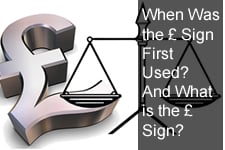Early Accounting: Pounds, Shillings, Pennies and Marks
- Written by: Gary Howes
Early Accounting: Pounds, Shillings, Pennies and Marks
Welcome to the third article in a series of insights into the fascinating past of the UK currency. Here we dwell on the accounting behind the Pound at the time of its formation around 1080 - 1100.
 When 'sterling began' in the period 1080 - 1100, the only coin of any kind was the penny, abbreviated as d. from the Latin denarius.
When 'sterling began' in the period 1080 - 1100, the only coin of any kind was the penny, abbreviated as d. from the Latin denarius.
There were 240d (12x20) that could be attained from one pound of metal.
(Remember, 'sterling' really was a silver metal, thus one could physically split the currency into smaller units of currency).
The shilling (s.) - a word we derive from the latin Solidus (a solid coin) - meant 12 pennies.
A halfpenny (farthing) was derived by cutting a penny into halves or quarters.
A mark was two-thirds of a pound. It was both a unit of weight and a unit of accounting and was worth 160d.
- one pound (£) = 20 shillings (s.) = 240 pennies (d.)
- one mark = 13.33 shillings = 160 pennies = 13s. 4d.
Courtesy of Nicolas Mayhew's book Sterling, The History of a Currency.
Nicolas Mayhew is Keeper of the Heberden Coin Room at the Ashmolean Museum and a fellow of the St Cross College, Oxford.

